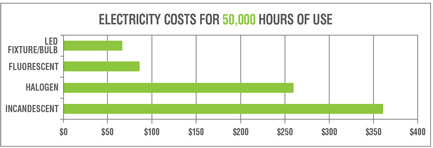Top Reasons To Use LED
Ready to see your property in the best light? LEDs are becoming the go-to lighting choice for property managers and maintenance pros. Here are some reasons why.
Lighting That Lasts
Tired of frequent bulb changes? Typically, an LED bulb will last 4 times longer than a CFL (compact fluorescent) and 25 times longer than an incandescent bulb that puts out the same amount of light. Many LEDs have a rated life of up to 50,000 hours.1

Used 12 hours a day, an LED bulb with
a lifespan of 50,000 hours could
last more than 11 years.
Efficient, Yes. Reliable, Always.
Residential LEDs, especially ENERGY STAR® rated products, use at least 75% less energy than incandescent lighting.2 The bottom line? LED bulbs can help you and your residents save energy and money on utility bills.

On In An Instant
Unlike CFL and HID (high intensity discharge) bulbs, LEDs reach 100 percent brightness almost instantly. LEDs can also be switched on and off frequently without shortening its lifespan. This makes LEDs ideal for in-home use and motion sensors.
Ideal For Hard-To-Reach Areas
Thanks to their long life, LED bulbs are perfect for pole lights and flood lights that are installed up high
and not fast and easy to get at.
Built-In Durability
Since there are no filaments, LED lighting is sturdy and rugged enough to withstand shock, vibrations, wind, and rain.
Light In All Shapes And Sizes
We offer LED versions of A-Shape, PAR (Halogen), BR (Reflector), MR16 (Halogen), Decorative, Linear Tubes, and HID bulbs—all create the same light output at a fraction of the wattage. Also, our LED fixtures are available in a variety of styles and finishes.
LEDs Can Become Even More Efficient As Temperatures Drop.
Traditional incandescent lighting can (and often do) overheat and burst in extreme cold. Because LEDs use heat more efficiently, they are a far better choice in cold weather environments and freezer rooms.
Better For The Environment
One LED bulb can typically last as long as 25 incandescent bulbs. LEDs also do not contain mercury, lead,
or other toxic materials. That means fewer bulbs and chemicals going into landfills.
